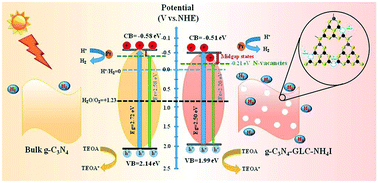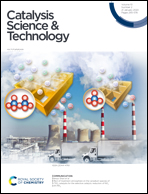Facile one-pot synthesis of mesoporous g-C3N4 nanosheets with simultaneous iodine doping and N-vacancies for efficient visible-light-driven H2 evolution performance†
Abstract
Direct and efficient visible-light water splitting by photocatalysis is essential for the sustainable conversion of solar energy into H2 fuel. In this study, mesoporous nanostructured g-C3N4 with simultaneously incorporated N-vacancies and iodine dopant was prepared by a straightforward one-step approach. The simultaneous thermolysis of glucose and NH4I resulted in several phenomena, including (i) synergistic exfoliation of iodine doped mesoporous g-C3N4, (ii) introduction of N-vacancies due to the release of more nitrogen-rich dynamic gases, and (iii) extended visible light absorption due to the strategic band positions of midgap states below the conduction band, which functions as an efficient reservoir to temporarily trap the radiative electrons in the modified g-C3N4. As a result, the as-synthesized iodine doped mesoporous g-C3N4 demonstrated an outstanding photocatalytic H2 evolution performance of 7819.2 μmol h−1 g−1 under simulated solar light irradiation, which was nearly 6.5 folds higher than that of the bulk g-C3N4 and other typical doped g-C3N4 photocatalysts. Our work proposed a simple and scalable route to synthesize high-performance metal-free g-C3N4 photocatalysts by changing the electron transition via rational band structure engineering.



 Please wait while we load your content...
Please wait while we load your content...